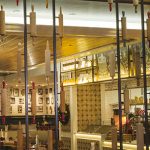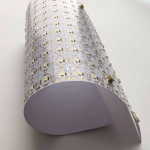Look to Lighting for Top Design

Designing an aesthetically pleasing and functional interior space involves many elements – surfaces, wall coverings, flooring, furniture, appliances, and lighting. You may think lighting design is one of the last components chosen when creating a space, but did you know planning for lighting design ahead of time can be cost efficient and can maximize the design’s effectiveness?
When executed properly, the best lighting design is completely user friendly and mostly unnoticeable. However, when poorly planned, lighting can compromise the design of any space. Lighting is one of those rare elements we immediately notice when it doesn’t measure up — too bright or too dim can ruin the overall effect of the design. Therefore, think of quality lighting design as an investment, not a cost.
Turning on the right light
Choosing the appropriate lighting and fixture depends on the application within the design – whether lobby, office, retail, healthcare, or other.
Incorporate task lighting in places for a certain purpose such as dressing rooms, counter space, or work areas.
Install accent lighting to highlight artwork, displays, and products throughout a retail store to create drama and interest. The correct design and installation will help guide the eye’s focus toward the highlighted feature.
Utilize ambient lighting to fill the spaces where other light sources fall short. Fixtures, such as downlights or linear luminaires, can provide shadow-free lighting when used in conjunction with other lighting applications.

Light color impacts design
Proper lighting enhances how products look to the viewer’s eye, and you can measure in several ways:
- Color temperature is a measurement of the light’s color appearance, and is usually referred to as warm or cool. Higher Kelvin temperatures (3600K–5500K) are considered cool and lower color temperatures (2700K–3000K) are considered warm.
- Color Rendering Index (CRI) assesses the impact of different light sources on the perceived color of objects and surfaces. The CRI scale ranges from 1-100; the higher the CRI value means the light source will render colors best. While a light source having a CRI greater than 90 is ideal, normally a value of 80 or higher is adequate.

Technique adds interest
Once you’ve selected the best fixtures for your design, you can add interest by incorporating diffusion, optics, and lighting controls (including dimming features).
Diffusion
Lighting can appear harsh because of light emitted in a single direction from a fixture. As a result, it becomes difficult to focus. Dark shadows will also be cast, possibly reducing visibility in the illuminated area. To solve this problem, light can be softened by diffusion, which is the scattering of the beam’s light rays in different directions.
Lighting controls
With today’s advanced technology, you have the ability to control multiple light sources from a personal device. This allows you to create complex lighting scenes. You can preset multiple scenes for different spaces in a room. Wireless controls can now be mounted to desks and furniture and LED lighting can be integrated almost anywhere. The design options for controlling lighting are just a switch, click or touch away – not to mention voice.
Dimming
Dimming allows the user to set the light level to where they want it, and then use a single control to program the light to a desired preset level. This also saves energy and extends the life of the light fixture. Many LED fixtures are now dimmable, but a low wattage light may require a specific type of dimmer to function properly.
As the latest lighting trends in technology, sustainability, and user friendliness continue to merge, opportunities for clever designs are endless. Specialty Lighting can expertly guide you through the process in finding the best solution for your lighting investment.
Contact Us
